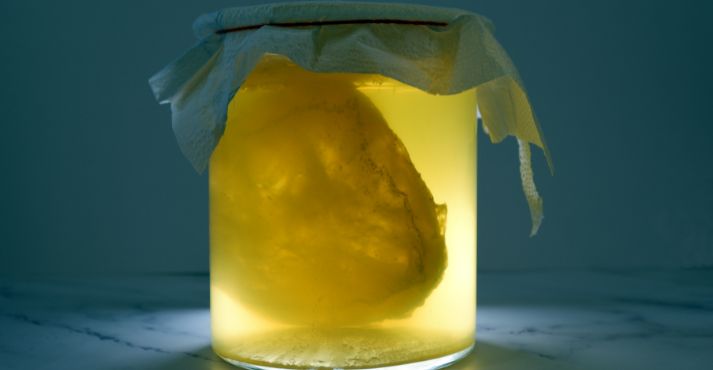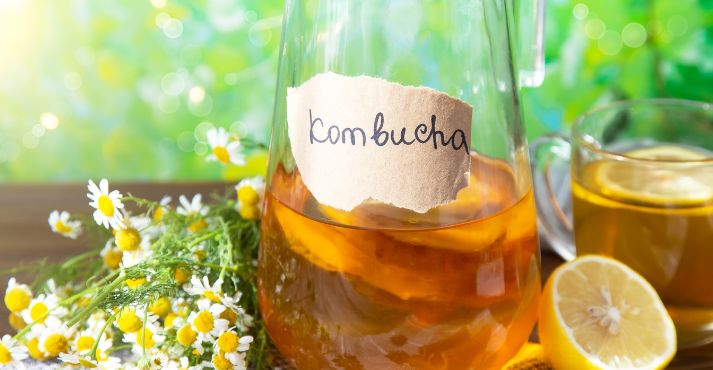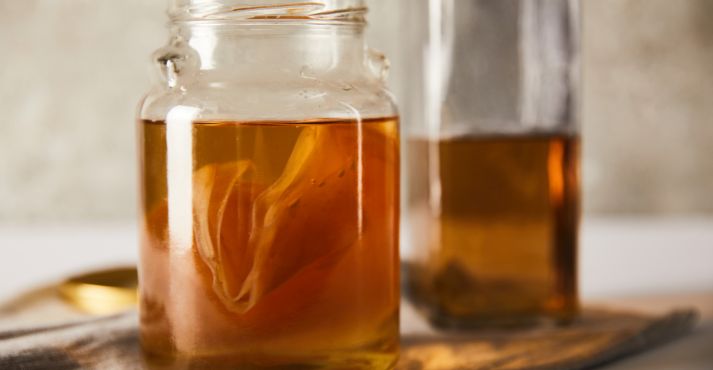Introducing Kombucha, the fermented tea beverage with deep cultural roots and gaining widespread popularity as a health beverage. This ancient elixir, born from the art of fermentation and tea brewing, offers a refreshing twist on probiotics.
As we delve into the world of Kombucha, we uncover not just a beverage but a tradition that has stood the test of time and is now making waves in modern wellness circles.
Discover the magic of fermented tea as we explore the origins, cultural significance, and growing allure of this probiotic-rich drink.
Brewing Kombucha: The Basics
Ingredients and Fermentation Unveiled
Let’s talk about brewing Kombucha – that fizzy, flavorful drink that’s both tasty and rumored to be good for you. It’s a tea, sugar, and a magical culture called SCOBY. Now, let’s break down how these basics become a bubbly beverage.
Ingredients:
Kombucha keeps it simple with three leading players – tea, sugar, and SCOBY (Symbiotic Culture of Bacteria and Yeast), which is a unique mix of bacteria and yeast used to ferment Kombucha. Tea provides the flavor, sugar fuels the fermentation, and SCOBY is part that transforms the mix into Kombucha.
Fermentation in a Nutshell:
During fermentation, SCOBY munches on the sugar and turns it into different compounds, creating a unique taste and bubbles in your Kombucha. It’s a natural process, like a tiny kitchen orchestra turning tea and sugar into a tangy, fizzy tune.
Why Tea and Sugar?
Tea brings flavor and some nutrients into the mix, whether black or green. Sugar is SCOBY’s food. As it eats up the sugar, your Kombucha gets less sweet and more tangy.
Meet SCOBY:
Think of SCOBY as the engine of Kombucha. It’s a community of tiny living things that make each batch unique. Plus, it adds good stuff like probiotics and organic acids – potential friends for your gut health.
Brewing Your Kombucha:
Making your Kombucha is as simple as mixing tea and sugar, adding SCOBY, covering it up, and letting nature work its magic. The result? A tangy drink ready for sipping. And if you’re feeling adventurous, you can add flavors in a second round of fermentation.
Brewing Kombucha is like a kitchen science project that results in a tasty, bubbly drink. Understanding the role of tea, sugar, and SCOBY lets you create a refreshing beverage that is good for you, too. Cheers to simple and satisfying Kombucha!
The Transformative Journey of Kombucha Fermentation

Let’s dive into the fascinating world of Kombucha fermentation, where the simple blend of tea, sugar, and SCOBY transforms into a tangy, effervescent elixir. This journey not only tantalizes your taste buds but also holds potential health benefits, thanks to probiotics.
Unraveling Fermentation:
Fermentation is the captivating process where SCOBY, the symbiotic mix of bacteria and yeast, feasts on the sugar in sweet tea. As they participate in this transformative process, they skillfully coordinate the development of a tangy, effervescent masterpiece.
Probiotics: Your Gut’s Allies:
Meet probiotics – the unsung heroes of the fermentation tale. During this process, the live bacteria grow and create a mix of flavors that change the sweet mixture into a tangy, nutritious drink that has an influence on the recent health trends in beverage industry.
Health Benefits Revealed:
As Kombucha ferments, probiotics multiply, resulting in a drink that might aid digestion and offer immune support. While scientific evidence is ongoing, many enthusiasts believe in probiotics’ potential health benefits to this effervescent drink.
The Tangy Metamorphosis:
Visualize this: sweet tea undergoing a meticulous transformation into a tangy delight. The outcome is not just a beverage; it’s a healthful elixir that combines flavor and potential well-being.
The fermentation journey of Kombucha is more than a chemical transformation; it’s a holistic experience. The tangy outcome delights your palate and introduces the potential for a healthier gut.
So, as you savor that effervescent Kombucha, you’re not just enjoying a drink – you’re experiencing the healthful magic of fermentation.
The Spectrum of Kombucha Flavors
Begin an enriching exploration of the diverse world of Kombucha flavors, where traditional elements harmonize with avant-garde innovations.
From classic brews to innovative blends, the spectrum of Kombucha varieties is as vast and vibrant as a palette of colors.
Traditional Elegance:
Traditional Kombucha flavors exude a timeless elegance. Picture the crisp notes of fermented tea, a touch of sweetness, and that unmistakable tanginess – a flavor profile cherished for generations.
Innovative Blends:
Now, let’s delve into innovation. Like alchemists, Kombucha brewers enhance their blends with various fruits, herbs, and spices. This infusion adds depth and creates a sensory tapestry that tantalizes taste buds.
Fruits, Herbs, and Spices:
The unique part of making Kombucha enjoyable is adding fruits, herbs, and spices. Envision indulging in Kombucha that captures the essence of strawberries, the invigorating freshness of mint, or the comforting warmth of ginger—a sensory experience with each sip.
The Creative Alchemy:
Kombucha brewing is a canvas for creativity. Brewers experiment with flavors, pushing the boundaries of taste. The outcome? Handcrafted Kombucha is different, offering many unique and exciting flavors.
Tasting the Rainbow:
Like tasting the rainbow, Kombucha flavors span a kaleidoscope of experiences. Each sip is an invitation to explore a world of tastes, from the familiar to the extraordinary.
In the domain of Kombucha, flavors are not just notes on the palate; they’re expressions of creativity and ingenuity.
Whether traditional or innovative, each type encourages you to enjoy the craft of making Kombucha. So, whether you prefer classic elegance or innovative blends, Kombucha stands ready to paint your taste buds with vibrant flavors.
Specialized Kombucha Brews

Specialized Kombucha brews open up a world of unique flavors and potential health benefits. Each variant is a crafted blend, offering a distinctive taste and character.
Green Tea Elegance:
Explore the refined notes of green tea in specialized Kombucha. This variant combines green tea’s earthiness with Kombucha’s enthusiasm, creating a refreshing and nuanced brew.
Herbal Infusions:
Indulge in the aromatic blend of herbal infusions in the art of Kombucha brewing. Lavender, chamomile, and other herbs add complexity to the brew, turning it into more than just a drink—an infusion.
Regional Delights:
Discover unique regional variations of Kombucha as you delve into diverse flavors from different areas. Each locale contributes to a tapestry of flavors, showcasing the diverse expressions of Kombucha from mountains to valleys.
Nuances in Taste:
Specialized Kombucha brews offer a spectrum of taste nuances. Each sip is a unique flavor exploration, from the grassy undertones of green tea to the floral hints in herbal infusions.
Health Benefits:
Uncover potential health benefits associated with specialized brews. Green tea brings antioxidants, while herbal infusions offer calming properties. Beyond taste, these brews may contribute to well-being.
In the domain of Kombucha, diversity extends beyond flavors. Specialized brews cater to varied palates and preferences, inviting you to discover the richness of taste and potential health benefits each variant brings.
The Health Benefits of Kombucha
Probiotics and Gut Health
Delving into the health benefits of Kombucha, one must recognize the starring role played by probiotics. These tiny warriors contribute to the tangy taste and wield potential benefits for our gut health.
The Probiotic Mixture:
Good bacteria working together make Kombucha healthy for you. These include lactic acid bacteria and yeast, working together to create the fizzy goodness and infuse the brew with probiotic richness.
Gut Microbiome and Well-Being:
Studies have suggested a strong link between Kombucha’s probiotic content and the well-being of our gut microbiome. A balanced microbiome is associated with improved digestion, nutrient absorption, and mental health.
Contributing to Digestive Wellness:
The probiotics in Kombucha play a crucial role in directing a digestive performance that promotes balance and well-being. They support the balance of good bacteria in the gut, aiding food breakdown and promoting overall digestive wellness.
Scientific Exploration:
Explore scientific findings that shed light on the probiotic content of Kombucha. While individual responses may vary, emerging research indicates promising connections between Kombucha consumption and a flourishing gut environment.
Holistic Health Harmony:
Kombucha’s contribution to gut health isn’t just about digestion; it’s about fostering holistic health harmony. A balanced gut microbiome has been linked to immune system support and may play a role in reducing inflammation.
As you savor the effervescence of Kombucha, know that you’re not just enjoying a beverage but potentially nurturing your gut health. The mix of helpful bacteria in every sip of Kombucha is a small but meaningful step towards promoting a healthy and flourishing gut.
Antioxidants and Nutrients
Explore the nutritional landscape of Kombucha, where the infusion of tea and the magic of fermentation unite to craft a beverage rich in antioxidants and nutrients.
Tea-Derived Antioxidant Power:
At the heart of Kombucha’s healthful aura lies the inherent goodness of tea-derived antioxidants. These potent compounds, such as polyphenols, unfold during brewing, imparting Kombucha with its potential to combat oxidative stress.
Fermentation Alchemy:
Witness the alchemy of fermentation enhancing Kombucha’s nutrient profile. The SCOBY transforms the tea and sugar into a concoction teeming with B vitamins, organic acids, and enzymes.
The mix of good things in Kombucha helps keep you healthy:
Discover the many ways Kombucha can be good for your health. Antioxidants, as guardians against free radicals, support overall well-being. The nutrient ensemble contributes to the nutritional tapestry of this effervescent elixir.
Bioavailability Unleashed:
The fermentation process not only enriches Kombucha but also enhances the bioavailability of nutrients. This means your body can more readily absorb the goodness, potentially amplifying the health benefits.
An Invigorating Sip:
With each refreshing sip, you’re indulging in a flavorful beverage and treating your body to a nutrient-packed elixir. Kombucha is good for you because it has antioxidants and nutrients that make you feel refreshed and healthy.
As you savor the delightful tang of Kombucha, relish that you’re not just enjoying a beverage – you’re embracing a potential source of antioxidants and nutrients. The artful blend of tea and fermentation has crafted a drink beyond taste, offering potential health benefits.
Making and Enjoying Kombucha at Home
DIY Kombucha Brewing
Unlock the joy of crafting your own Kombucha with this beginner-friendly DIY guide. Delve into the art of homebrewing and witness the magic unfold in your kitchen.
Essential Elements for Your Brewing Process:
Before making Kombucha, ensure you have the necessary items: a brewing vessel, tea, sugar, and a SCOBY. These are the instrumental elements for your home fermentation adventure.
The Brewing Process:
Navigate through the complex steps of the brewing process with precision and expertise. From preparing sweet tea to introducing the SCOBY and allowing the fermentation magic to commence, each step is a choreographed move toward your effervescent elixir.
Patience – The Secret Ingredient:
In the domain of homebrewing, patience is the secret ingredient. Allow your Kombucha to interact with the SCOBY for the recommended duration, enabling the flavors to blend and effervescence to develop.
Bottling Excitement:
As your homebrew reaches its crescendo, the bottling phase adds a layer of excitement. Witness the transformation of your concoction into a fizzy beverage, ready to be enjoyed.
Savoring the Fruits of Your Labor:
The moment has arrived – your DIY Kombucha is ready to be savored. Pour a glass, relish the enthusiasm, and bask in the satisfaction of crafting a healthful, homemade elixir.
Brewing Kombucha at home is not just a process; it’s a journey of discovery and joy. With the right ingredients, patience, and a love for the craft, you can indulge in the pleasure of creating your effervescent masterpiece.
Kombucha Cocktails and Culinary Uses:
Kombucha isn’t just a beverage; it’s a versatile ingredient that can elevate your culinary and mixology game. Let’s explore creative ways to enjoy Kombucha beyond the classic sip.
1. Mixology Magic:
Unleash your inner mixologist by incorporating Kombucha into cocktails and mocktails. Whether it’s a Kombucha-infused mojito or a refreshing virgin Kombucha punch, the possibilities are as endless as your creativity.
2. Culinary Fusion:
Take your culinary skills to new heights by infusing Kombucha into dishes. From salad dressings with a tangy twist to Kombucha-marinated proteins, the fermented tea adds a unique flavor to your culinary creations.
3. Mocktail Mingle:
For a non-alcoholic treat, experiment with Kombucha mocktails. Combine different flavors with
fresh herbs, fruits, and a dash of creativity to craft refreshing mocktail concoctions that dazzle the taste buds.
4. Kombucha in the Kitchen:
Dive into the culinary domain with Kombucha-infused recipes. Try your hand at Kombucha-glazed vegetables, where the tangy notes add depth to the dish, or explore dessert innovations like Kombucha sorbet for a sweet surprise.
5. Kombucha Pairing Pleasure:
Discover the art of pairing Kombucha with various cuisines. The enthusiasm and diverse flavor profiles make it a versatile companion, enhancing the dining experience with each sip.
Addressing Common Questions and Concerns
Alcohol Content in Kombucha
One common question that often bubbles up about Kombucha is its alcohol content. Let’s pour out the details on this fizzy concern.
1. Brewing Dynamics:
The alcohol content in Kombucha is a natural byproduct of fermentation. Factors like fermentation time, temperature, and the types of cultures used contribute to the alcohol levels.
While most homemade versions stay within the non-alcoholic range, it’s essential to be mindful of the brewing process.
2. Store-Bought vs. Homemade:

Commercially available Kombuchas undergo strict control measures to limit alcohol content, making them a reliable choice for those concerned about moderation.
However, if you’re on a homebrewing adventure, managing alcohol levels requires a bit of know-how. Consider shorter fermentation times or explore alcohol-testing kits for precision.
3. The Sweet Spot:
Finding the right balance between taste and alcohol content is critical. Opt for shorter brew times with a sweeter, less fermented taste.
For those embracing the tangier notes and potentially higher alcohol content, a more extended fermentation period might be your brew of choice.
4. Sipping Responsibly:
For those cautious about alcohol intake, it’s wise to sip mindfully. Check labels when selecting store-bought options and experiment with different brewing techniques at home to align your Kombucha preferences with your lifestyle choices.
5. The Art of Moderation:
Like any beverage with trace alcohol, moderation is key. Embrace the art of moderation whether you’re crafting your batches or selecting from the array of commercially available Kombuchas. This way, you can relish the effervescence without the worries.
Kombucha and Candida
Let’s shed some light on the intriguing connection between Kombucha and Candida, addressing concerns and demystifying the sugar saga.
1. The Sugar Spectacle:
One often wonders about the sugar content in Kombucha and its implications, especially in the domain of Candida overgrowth.
Here’s the scoop: during fermentation, the sweet tea base transforms into Kombucha, and the sugar is consumed by the SCOBY. However, residual sugars might remain, making it a tad sweet.
2. Candida’s Sweet Tooth:
Individuals with Candida overgrowth are often cautious about sugar intake, which can exacerbate their condition.
The residual sugars in Kombucha may concern some, as Candida tends to thrive on sugars. It’s a delicate balance between enjoying the tangy goodness and being mindful of sugar levels.
3. Candida-Friendly Options:
The good news is that you have options if you’re watching your sugar intake due to Candida’s concerns. Opting for shorter fermentation times or a secondary fermentation where more sugars are consumed can lead to a brew with lower residual sugar, making it more Candida-friendly.
4. Listen to Your Body:
As with any dietary choices, listening to your body is crucial. If you have Candida-related concerns, observe how your body responds to Kombucha.
Some individuals find it a delightful addition to their diet, while others may limit their intake or explore sugar-conscious brewing methods.
5. A Balancing Act:
Balancing the benefits of Kombucha with individual health considerations is critical. Candida management involves personalized approaches, and if Kombucha aligns with your wellness goals, exploring variations that suit your sugar sensitivity can be part of the journey.
Conclusion
In conclusion, Kombucha is more than just a beverage; it’s a journey into cultural traditions, the art of brewing, and a gateway to health benefits.
From its ancient roots to its contemporary popularity, Kombucha offers a versatile and enjoyable way to incorporate probiotics into one’s lifestyle. Whether sipped solo or blended into creative concoctions, the possibilities are diverse.
As we explore the richness of Kombucha, let’s embrace responsible consumption and continue to savor the goodness that this fermented tea brings to our well-being.






























